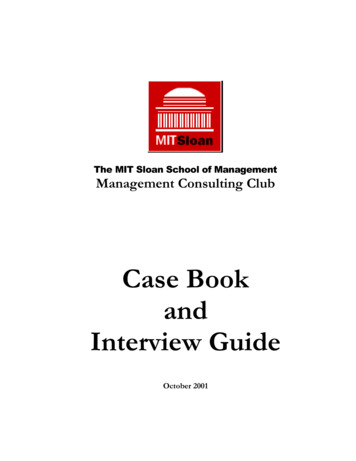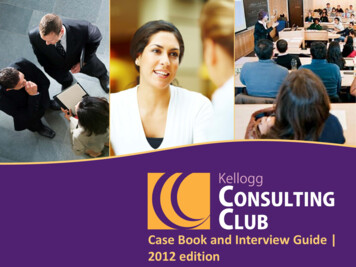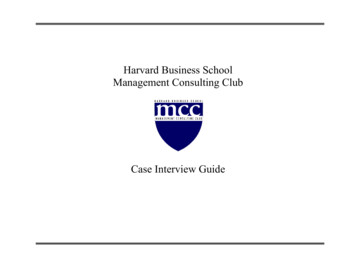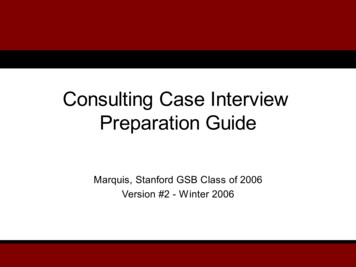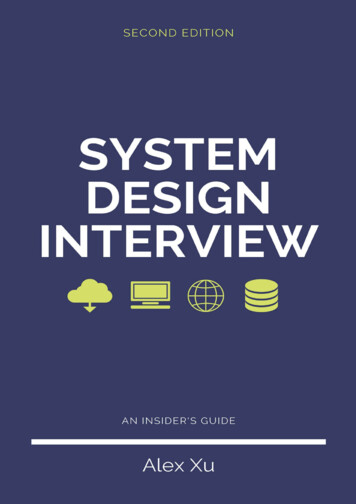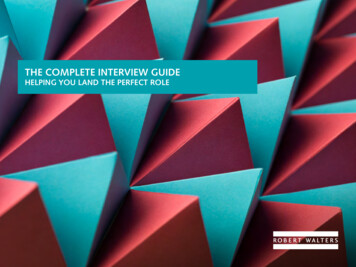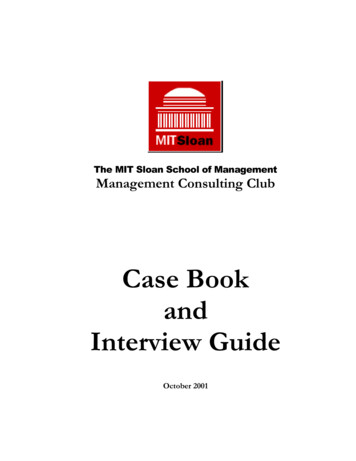
Transcription
The MIT Sloan School of ManagementManagement Consulting ClubCase BookandInterview GuideOctober 2001
The MIT Sloan School of ManagementManagement Consulting ClubMany thanks to the MCC Case Book and Interview Guide Sponsors:Gold Sponsor:Case Contributors:iManagement Consulting Club2001-2002 Case Book and Interview Guide
Table of ContentsIntroduction.3Financial Concepts.43Chapter 1: How to Use the Case Book andInterview Guide .5Accounting Concepts .46Chapter 2: Etiquette and the InterviewProcess.6Chapter 8: Practice Cases and Solutions57Chapter 3: The Personal Interview .7Format. 7Preparation . 7The Physical Factors of Interviewing . 11“Any questions for me?” . 12After the Interview. 13Chapter 4: Typical Personal InterviewQuestions .15Be prepared for these! . 15Possible approaches to tough questions 17Chapter 5: The Case Question .21Format. 21Micro and Macroeconomic Concepts.54Brain Teasers.57Market Sizing .63Operations .69Strategy .105Other Cases .158Chapter 9: Sources for More Help.165About the Consulting Industry .165Researching Consulting Firms.166Personal Interviewing.166Case Interviews .166Appendix: Recent Cases Provided byConsulting Firms .167Preparation . 22Types of Cases . 22Practice Cases: sample cases . 27Case Interview Tips. 28Chapter 6: Consulting Frameworks andTools .30Typical business issues and relatedframeworks . 31Profitability Analysis . 32Market expansion and OpportunitiesAssessment . 33Competitive analysis: The 3 C’s Customer, Company, Competition . 40Marketing strategy: the 4 P’s. 41Chapter 7: Basic Financial, Accountingand Economic Concepts .43iiManagement Consulting Club2001-2002 Case Book and Interview Guide
IntroductionDear Club Member,Welcome to your first step in a rewarding career as a management consultant: the interview process. Yourfellow club members produce the Case Book and Interview Guide to give you a head start as you workthrough the long process of getting that dream job offer.MIT Sloan is arguably the most successful business school in the world for training managementconsultants and, just as importantly, placing them with firms.Just consider these facts: Nearly 40% of MIT Sloan students go into the consulting profession on leaving Sloan. The median base starting salary for MIT Sloan students entering consulting in 1999 was 95,000 and the median total compensation 140,000.This status will be maintained partly by the standard of interactive preparation. We recommend youuse this casebook and other resources to practice, practice, and practice again. The consulting club willprovide further help through its Buddy system, the Case Preparation Workshop program, and other caseworkshops.Please let us know your comments on the content of this book so that we could make it even better nextyear. A questionnaire will be posted on Sloan Space. We look forward to hearing yoursuggestions!Finally, thanks to all the students who contributed and produced the casebook. It could not have beendone without you.Good Luck!Your club officers,Jamshed CooperPetia KoutevTheresa LagosKamal NarangJimmy Zhang3Management Consulting Club2001-2002 Case Book and Interview Guide
1ChapterChapter 1: How to Use the CaseBook and Interview GuideAs you can see from the table of contents, the Case Book and Interview Guide is composed of eightchapters. These are our recommendations on how to use this book: Read chapter two, ETIQUETTE AND THE INTERVIEW PROCESS and chapter three, THEPERSONAL INTERVIEW first. This will give you an idea of what the interview process is like. Look over chapters four and five, TYPICAL PERSONAL INTERVIEW QUESTIONS andTHE CASE QUESTION next. This will give you a deep understanding of what yourinterviewers will be looking for. Now read chapter six, CONSULTING FRAMEWORKS AND TOOLS. Much of this materialwill be familiar to you. It is the sort of stuff you are paying lots of money to learn at Sloan. Then PRACTICE (we will say this more than once in this book)! Link up with at least twoclassmates. One plays the interviewer, one plays the interviewee, and one observes. Runthrough an actual 30-minute interview. Include some personal questions at the start. In short,role play an interview, keeping the tone as serious as you expect to find the real situation. Try to practice with different people to get used to different styles of interviewing, hear morefeedback, and to observe what works and what doesn’t. Finally, attend Case Preparation Workshops to learn from the experts. Use your Buddy asanother source of insight. Second year Buddies are more than happy to practice cases with you!5Management Consulting Club2001-2002 Case Book and Interview Guide
2ChapterChapter 2: Etiquette and theInterview ProcessYour performance in this area affects not only you, but also the reputation of MIT Sloan, itsstudents, and its alumni. Please keep the following in mind Your professionalism says a lot about you and MIT Sloan. Any lack of professionalism will havean even greater and more lasting effect! Here are the rules of interviewing: Don’t break therules! Follow through on your commitments. Don’t leave corporate presentationsearly! If you must, sit by the door and be discrete. If you sign up for an interviewor a company dinner – go. If you must cancel, do so well in advance so someoneelse can have your spot. Be early. A 9:00 a.m. interview means you should be in with your interviewer at9:00, not taking off your coat and signing in. If they are running late and thisimpacts your schedule, be gracious and work with the coordinator to remedy thesituation. Getting agitated won’t help. Be prepared. Employers are very sensitive to people who come in and try to“wing it”. This reflects poorly on both you and MIT Sloan. So if you aren’tgenuinely interested, don’t take the spot from someone who might really want it. Celebrate discretely. Once you get a job offer, you will have the urge to gosinging through the streets. Just remember, many of your friends are still lookingand for them the disappointment is mounting. Collaborate rather than compete. By helping one another out, we will all beprepared to do our best. This will encourage more companies to recruit at Sloanand for those already here, to hire greater numbers of students.6Management Consulting Club2001-2002 Case Book and Interview Guide
3ChapterChapter 3: The Personal InterviewYou may be tempted to just practice case interview questions and “wing it” through the personalportions. Don’t make this mistake! Your interviewer is just as interested in how you “fit” the firm ashow fast you can chug through that industry analysis case. So here are some pointers gleaned fromvarious interviewing books and Sloanies’ experiences. Disclaimer: Some of this may be commonsense, but a little reminder never hurts!FormatThe “typical” consulting interview for a summer internship consists of two rounds. The first round is ascreening round. You will normally interview with two consultants from the firm, one consultant for eachinterview. If you do well, you will be invited back, often the next day, for a second round of interviews. Inthe second round, you may have two or three interviews with different consultants. These consultants willusually be from your desired office or specialty.The process is a little different for permanent positions. You will usually have three rounds rather thantwo. The third round will probably be at your desired office.Each interview lasts from a half hour to 45 minutes. The first half of your screening round interviews willusually be the “personal interview” portion. You will usually receive a case question after 15 minutes ofpersonal questions.Prior to any case question, expect five minutes of chitchat. Yes, this is part of the personal interview!What is the purpose of the personal interview questions? Well, the firm wants to know why you want tobe a consultant and why you want to join their firm. They are also trying to assess your “fit” with the firmand test whether you have researched their firm appropriately to make an informed decision if they makeyou an offer. The bottom line: If you don’t impress your interviewer in the personal portion, yourperformance on the case questions will not matter!PreparationThe key to performing well in the personal interview portion is preparation. Don’t make the mistake ofonly practicing cases with your friends and Management Consulting Club buddy, or even worse, reading7Management Consulting Club2001-2002 Case Book and Interview Guide
this case book on your own and “winging it.” You need to anticipate the questions yourinterviewer will ask and have a story that incorporates your skills and ties them to your desire andqualifications to be a management consultant with the firm you are pursuing. And don’t forgetthat the “personal interview” extends throughout the recruiting process!There are three key points to remember for a successful personal interview. Know Yourself Know the Firm Listen WellAs you go through the interview process, you will receive tough questions that probe not onlyyour intentions and intellect, but also your psyche and personality. Your delivery is as importantas what you say. The only way to show poise and grace while answering these tough questions ispractice over an extended period of time!Know YourselfYou need to create a story line for yourself. Describe how your life has developed such that a jobwith firm X is the next logical step in reaching your goals. Be able to walk through the details ofyour resume and fill in the details. For instance, why did you make the moves you have? Whathave been the most significant decisions you have made? Where were the challenges and wherewere the triumphs? This is also your chance to set yourself apart. Give the interviewer somethingto remember you by – tell an interesting story, talk about a unique skill or talent, etc. One way todo this is to incorporate words that will provoke curiosity into your resume. Given the recentsurvey on employers’ perceptions of Sloan students, you should be prepared to emphasizeteamwork, communication skills and business savvy.The CDO offers many sessions where you learn to match your personal assets and strengths tothe career you are considering. You will also learn to mitigate weaknesses in your skills orbackground. Take advantage of these sessions, as they will help you learn the self-insight that isrequired to answer your interviewer’s questions honestly and persuasively.Also, be aware of the recruiters’ perceptions that they have even before meeting you for theinterview. Try to break the negative reputation and re-enforce the positive. Below we haveincluded the study conducted by CDO where recruiters were asked what do they think aboutSloan students.First, the positive recruiter perception of SloanSloanies are super smart academically and quantitatively excellentSloanies are approachable and helpfulGood, just do not let them think that you cannot aggressively go after a job or develop newbusiness. Also, show them creative thinking not only number crunching ability.8Management Consulting Club2001-2002 Case Book and Interview Guide
Now the negative impressions:Some recruiters believe Sloanies are not team orientedSloanies have less business savvy than other MBA’sSloanies lack etiquetteSloanies are not the best in interpersonal and communication skillsSloanies solve too many problems on paperSloanies often demonstrate depth vs. breadth in interviewsSloanies are not strong in selling themselves in interviewsFinally, some recruiters believe that Sloanies are under-prepared for their interviewsNow that you are aware of these stereotypes, you may work on them to improve your chances of gettingthe job. Make a strong effort to cite examples of teamwork. Be on time for your interview and properlydressed, remember that an interviewer is checking whether he/she can put you in front of a client. Todemonstrate breadth of the case analysis, skim the surface of the most salient issues and then go intodetail when prompted by the interviewer. To summarize, leverage these myths by showing that in additionto being a smart, helpful, numbers person, you are also a creative, thoughtful, well-mannered, personable,and savvy business student ready to sell ideas to clients that will positively impact their bottom line.Know the FirmWhat does the firm pride itself on? What makes them unique? If a firm prides itself on being a thoughtleader, show how you have been a thought leader or why being part of a firm that leads the industry isimportant to you. You must also know the basics about a company such as where they have offices andhow they are structured. If you are unclear about any of these areas – ask! You do, however, want to sho
2001-2002 Case Book and Interview Guide 1Chapter Chapter 1: How to Use the Case Book and Interview Guide As you can see from the table of contents, the Case Book and Interview Guide is composed of eight chapters. These are our recommendations on how to use this book: Read chapter two, ETIQUETTE AND THE INTERVIEW PROCESS and chapter three, THE
